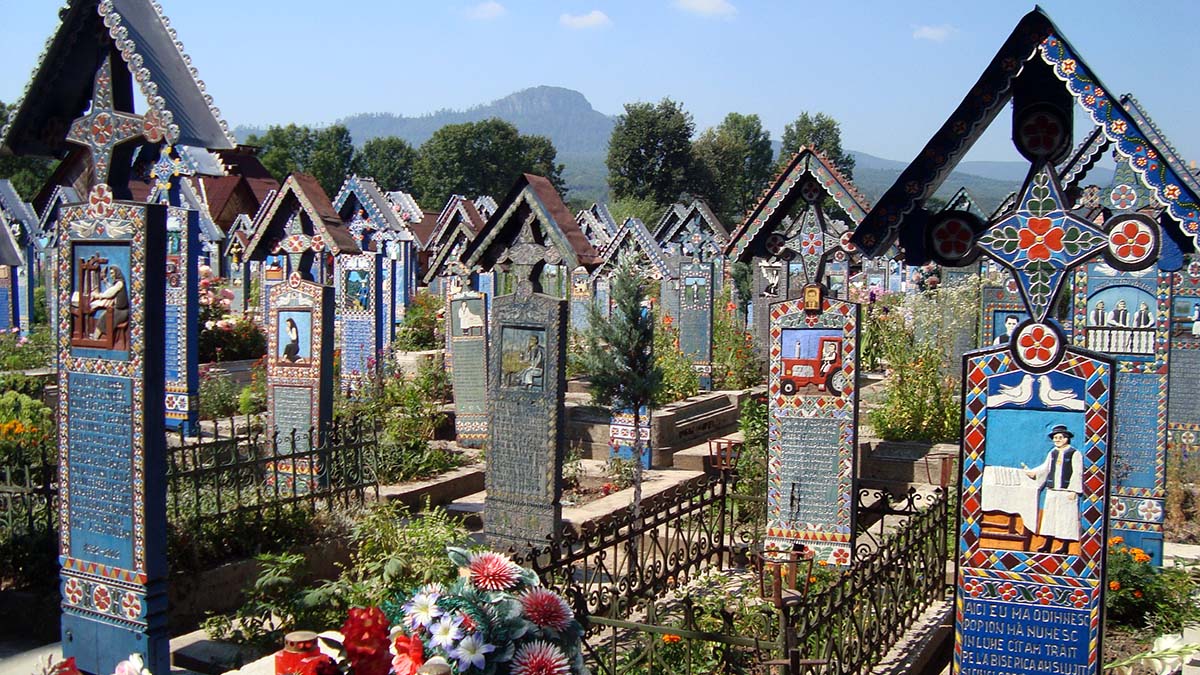
Transylvania, Romania
by Iolanda Scripca
In the twenty-four years of my life I spent in Romania, I never had the occasion to visit a unique place in Transylvania called the Merry Cemetery.
So, about two months ago, I called my childhood friend in Romania and asked if she wanted to join me on an adventure that would take us from Bucuresti – the capital of Romania and our native city – to Maramures, a region way up north, in Transylvania. It is said that if you do not visit Maramures you do not know the real Romania.
My friend jumped with joy at the idea, and soon I was making airplane reservations.
I landed in Bucuresti at 3:00 a.m., a long flight that took me over the U.S., Canada, Iceland, Germany and, finally, Romania. Gabriela was waiting for me at Bucuresti’s International Airport Otopeni. We hugged for a long time, as excited as two little girls who’d just seen the ice-cream truck approaching.
The next day we took the train from Bucuresti to Sighetu Marmatiei – a city along the Tisa River on the Ukrainian border. The long ride allowed us to reminisce over our carefree childhood, places, the other kids and the “whatever happened to David?” kind of things.
Maramures’s beautiful landscape takes you back to a time when life was simpler. Village houses are still built the traditional way, and the residents still wear traditional, handmade clothes decorated with colorful patterns and from cloth that originated from local fields. The villagers are particularly helpful and friendly.
Once in Sighetu Marmatiei, we stayed in a picturesque bed and breakfast. From there we joined a touring bus and headed to Sapânta (sah-PUNTS-ah), where the famous Merry Cemetery is located. It is not a simple cemetery any longer, but a place where visitors pay a few pennies to look around– an outdoor museum, if you will.
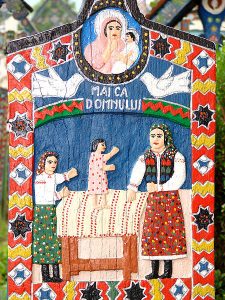 The over 600 multicolored crosses carved in oak stand about five feet tall; each is protected by two wooden beams in a shape of a roof. Each cross is personalized with the deceased figure at the center and a scene of his life, carved in a folk Naïve style, followed by a witty epitaph that informs the living how and why that person died. From the lumberjack to the barber to the shepherd, these crosses depict a nostalgic village life (and even death), a visual historical chronicle of that particular place and time. The colors used by the founder of this cemetery, Stan Ioan Patras, are all symbolic to the life of each deceased: red for passion, yellow for fertility, green for life, and black for untimely death.
The over 600 multicolored crosses carved in oak stand about five feet tall; each is protected by two wooden beams in a shape of a roof. Each cross is personalized with the deceased figure at the center and a scene of his life, carved in a folk Naïve style, followed by a witty epitaph that informs the living how and why that person died. From the lumberjack to the barber to the shepherd, these crosses depict a nostalgic village life (and even death), a visual historical chronicle of that particular place and time. The colors used by the founder of this cemetery, Stan Ioan Patras, are all symbolic to the life of each deceased: red for passion, yellow for fertility, green for life, and black for untimely death.
All of this makes for over 600 stories visitors can read about: the shepherd who was unaware of the murderous robber behind him, the young man old enough to marry who was struck by lightning in the fields, the little six-year-old girl who died prematurely, even an epitaph about the village drunk.
Here I lie to take my rest
They call me Stan Gei Crautu
Since I was a child I loved my sheep much
But a bad rabbit horse splattered me all over
Took away my life
Mother and father will wail for me as long as they live
Death, you have an ugly name
as you carried me away young
and took my life at age 14.
After the cemetery founder passed away, his followers continued his artistry, and one notices the progress in the passing of time. A more recent epitaph explains the cause of one boy’s death – an accident in the subway in Paris while he was fooling around on his roller blades. Many of the present-day stories tend to involve trucks, cars, trains.
Here I lie to take my rest.
Pop Mihai Sustac is my name.
Nobody should have bad luck
As I had when learned about the tractor
Far away from my village.
Death there found me
And young it took me away.
As we left this unique place, we looked at the tourists’ faces. They were intrigued, and maybe, in my opinion, a little more “at ease” with the idea of the dead and dying. This interesting, fulfilling trip that reunited me with my childhood friend couldn’t help but make me more aware of what life is all about – remembering your family and friends and how important they should be!
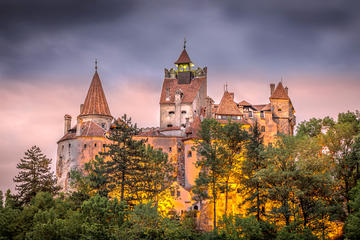
Taste of Transylvania Private Tour – from Dracula and Peles Castles to medieval Brasov
If You Go:
About the author:
Iolanda Scripca is a published photographer, poetess, journalist, and translator. She lived in Eastern Europe for the first twenty four years of her life, in a loving family. Her mom was a teacher, a high school principal, and a cultural promoter. Her dad was a published novelist, poet and TV producer. An unforgettable moment was her collaboration with her Dad in the translation and adaptation of a children’s book by the Bulgarian author Leda Mileva. She is a graduate of Foreign Languages and Literatures from the University of Bucuresti/Romania. Nowadays she enjoys Southern California and possesses a CA Teaching Credential from Chapman University. Ms. Scripca publishes in several Romanian-American Newspapers both in Romanian and English. “Lava Of My Soul” is her recently released collection of poems and essays. scripca@aol.com.
Photo credits:
Merry Cemetery, Sapanta, Maramures, Romania by Avramescu Marius / CC BY-SA
Merry Cemetery – Sapanta – Romania by Avramescu Marius / CC BY-SA

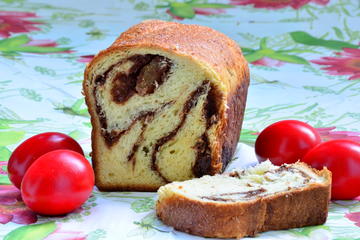
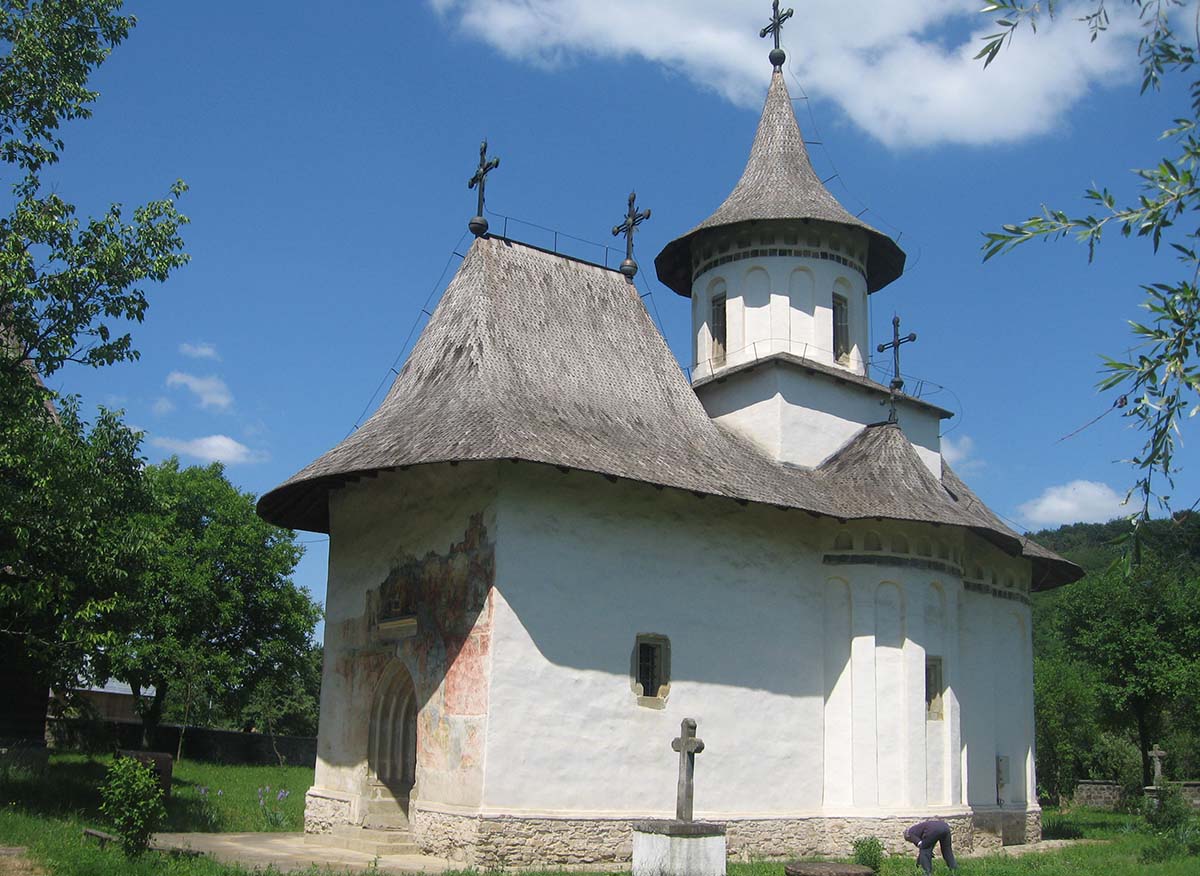

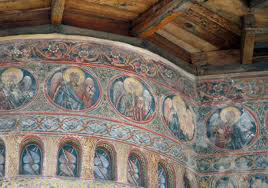 In the twenty-four years of my life I spent in Romania, I only once had the occasion to visit a unique region of Romania called Moldova and I was just nine years old then.
In the twenty-four years of my life I spent in Romania, I only once had the occasion to visit a unique region of Romania called Moldova and I was just nine years old then.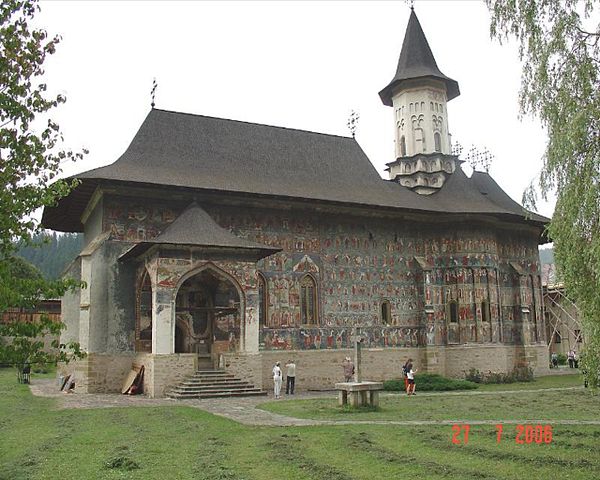 Entering the church, you are inclined to approach solemnly and humbly. Passing two separate stands that hold hundreds of thin yellow candles lit for the souls of the departed, you head slowly towards the altar, mesmerized by Byzantine-influenced icons and priests in holy attire. It was quite a thrill to be free to explore my own religion, free from the Communist regime which totally discouraged the population to go to church and believe in a higher power.
Entering the church, you are inclined to approach solemnly and humbly. Passing two separate stands that hold hundreds of thin yellow candles lit for the souls of the departed, you head slowly towards the altar, mesmerized by Byzantine-influenced icons and priests in holy attire. It was quite a thrill to be free to explore my own religion, free from the Communist regime which totally discouraged the population to go to church and believe in a higher power.


 After a few days of checking out the architecture in the bustling capital Bucharest, we board a train for Transylvania – one of the largest and most picturesque regions in the centre of Romania known for its historical mix of flavours of the old Austro-Hungarian Empire, Saxons and brief Ottoman rule.
After a few days of checking out the architecture in the bustling capital Bucharest, we board a train for Transylvania – one of the largest and most picturesque regions in the centre of Romania known for its historical mix of flavours of the old Austro-Hungarian Empire, Saxons and brief Ottoman rule. The Black Church (Biserica Neagra) towers in its dusky beauty in Council Square. Called St. Mary’s from the time the first stone was laid in 1385, until it was renamed in 1689 after its walls were blackened by the “Great Fire” that levelled most of the town. Five richly decorated portals grace the outside. On the inside over 100 Persian rugs are hung from the walls (given to the church by Saxon merchants returning from shopping-sprees to Ottoman lands). In 1839 a 4000-pipe organ was installed. It is a thrill to hear it being played; its thunderous chords setting off tremors in the air waves.
The Black Church (Biserica Neagra) towers in its dusky beauty in Council Square. Called St. Mary’s from the time the first stone was laid in 1385, until it was renamed in 1689 after its walls were blackened by the “Great Fire” that levelled most of the town. Five richly decorated portals grace the outside. On the inside over 100 Persian rugs are hung from the walls (given to the church by Saxon merchants returning from shopping-sprees to Ottoman lands). In 1839 a 4000-pipe organ was installed. It is a thrill to hear it being played; its thunderous chords setting off tremors in the air waves. Vlad III was the ruling prince of the Romanian state of Walachia from 1456-62, and from 1476-77, who offered a strong resistance to the westward expansion by the Ottoman Turks. His moniker Dracula was inherited; it means “son of the dragon” after his father Vlad II Dracul, who was a knight in the Order of the Dragon established to protect Christianity in the land. The symbol of this medieval order was a dragon, or “dracul” which at the time had a positive import, but after the 5th century became a symbol for the Devil. Vlad III’s infamy and his acquired moniker “Tepes” or Impaler, arose from his inhumane method of dealing with his enemies; foreign invaders and also rebellious countrymen, including noblemen (along with their families) who he felt were traitors and conspirators in the death of his father and brother. It is said dozens at one time were skewered on a wooden stakes in such a manner that instead of instant death, the victims suffered excruciating pain for up to 48 hours before their earthly farewell. It is believed that Vlad Tepes never set foot in Bran Castle….but there is a historic mention of his troops passing through Bran in 1459, and if going along on military manoeuvres was the Count’s modus operandi…who knows?
Vlad III was the ruling prince of the Romanian state of Walachia from 1456-62, and from 1476-77, who offered a strong resistance to the westward expansion by the Ottoman Turks. His moniker Dracula was inherited; it means “son of the dragon” after his father Vlad II Dracul, who was a knight in the Order of the Dragon established to protect Christianity in the land. The symbol of this medieval order was a dragon, or “dracul” which at the time had a positive import, but after the 5th century became a symbol for the Devil. Vlad III’s infamy and his acquired moniker “Tepes” or Impaler, arose from his inhumane method of dealing with his enemies; foreign invaders and also rebellious countrymen, including noblemen (along with their families) who he felt were traitors and conspirators in the death of his father and brother. It is said dozens at one time were skewered on a wooden stakes in such a manner that instead of instant death, the victims suffered excruciating pain for up to 48 hours before their earthly farewell. It is believed that Vlad Tepes never set foot in Bran Castle….but there is a historic mention of his troops passing through Bran in 1459, and if going along on military manoeuvres was the Count’s modus operandi…who knows? Built in 1377 it was mainly a fortress over the centuries to protect Romanian borders. In the early 20th century the town of Brasov gave the castle to Queen Marie of Romania. She absolutely loved each of its 57 rooms and she made it a summer retreat for her family of six children and King Ferdinand, when he wasn’t called away with kingly duties. She hired Czech architect, Karel Liman who imparted the castle with its romantic appeal and added to the comfort with heating stoves of Saxon tile, running water, electricity, three telephones and an elevator.
Built in 1377 it was mainly a fortress over the centuries to protect Romanian borders. In the early 20th century the town of Brasov gave the castle to Queen Marie of Romania. She absolutely loved each of its 57 rooms and she made it a summer retreat for her family of six children and King Ferdinand, when he wasn’t called away with kingly duties. She hired Czech architect, Karel Liman who imparted the castle with its romantic appeal and added to the comfort with heating stoves of Saxon tile, running water, electricity, three telephones and an elevator. We make our way up creaky wooden staircases, through narrow passage carved into the rock, and in and out of the high-ceilinged rooms, several of which overlook the courtyard dotted with potted red geraniums to enliven the castle’s sombre tones. Queen Marie’s bedroom and study are restored with ornate hand-carved furnishings, but not in the least opulent. The combined music room and library converted from an old attic is the largest room, and is as cozy as this stone edifice can be with a fireplace, a bear-hide rug and padded furniture.
We make our way up creaky wooden staircases, through narrow passage carved into the rock, and in and out of the high-ceilinged rooms, several of which overlook the courtyard dotted with potted red geraniums to enliven the castle’s sombre tones. Queen Marie’s bedroom and study are restored with ornate hand-carved furnishings, but not in the least opulent. The combined music room and library converted from an old attic is the largest room, and is as cozy as this stone edifice can be with a fireplace, a bear-hide rug and padded furniture. It is then on to Rasov, well at least to the bottom of the hill where it is perched, as the fortress was closed to renovations. Leaving the town of Rasov, Maxim points and says, “Gypsies”. We pass a rickety canvas-covered wagon pulled by two hefty steeds. A swarthy young man in a wide-brimmed hat jiggles the reins from the driver’s seat. His dark good looks are matched in the gypsy woman we later encounter. Alas, the romanticised lore of the Roma being free-spirited nomads is far from true – strong-spirited would be more fitting.
It is then on to Rasov, well at least to the bottom of the hill where it is perched, as the fortress was closed to renovations. Leaving the town of Rasov, Maxim points and says, “Gypsies”. We pass a rickety canvas-covered wagon pulled by two hefty steeds. A swarthy young man in a wide-brimmed hat jiggles the reins from the driver’s seat. His dark good looks are matched in the gypsy woman we later encounter. Alas, the romanticised lore of the Roma being free-spirited nomads is far from true – strong-spirited would be more fitting.
